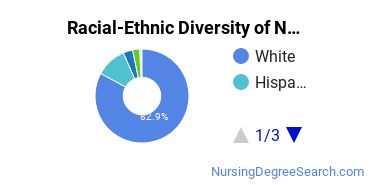Nursing at Provo College
If you are interested in studying nursing, you may want to check out the program at Provo College. The following information will help you decide if it is a good fit for you.Provo College is located in Provo, Utah and approximately 579 students attend the school each year.
Want to know more about the career opportunities in this field? Check out the Careers in Nursing section at the bottom of this page.
Provo College Nursing Degrees Available
- Bachelor’s Degree in Nursing
Nursing Student Demographics at Provo College
Take a look at the following statistics related to the make-up of the nursing majors at Provo College.
Provo College Nursing Bachelor’s Program

About 81% of those who receive a bachelor's degree in nursing at Provo College are white. This is above average for this degree on the nationwide level.
The following table and chart show the race/ethnicity for students who recently graduated from Provo College with a bachelor's in nursing.

| Race/Ethnicity | Number of Students |
|---|---|
| Asian | 0 |
| Black or African American | 3 |
| Hispanic or Latino | 13 |
| White | 112 |
| International Students | 0 |
| Other Races/Ethnicities | 10 |
Concentrations Within Nursing
Nursing majors may want to concentrate their studies in one of these areas. The table shows all degrees awarded in this field awarded for all degree levels at Provo College. A concentration may not be available for your level.
| Concentration | Annual Degrees Awarded |
|---|---|
| Registered Nursing | 123 |
Related Majors
Careers That Nursing Grads May Go Into
A degree in nursing can lead to the following careers. Since job numbers and average salaries can vary by geographic location, we have only included the numbers for UT, the home state for Provo College.
| Occupation | Jobs in UT | Average Salary in UT |
|---|---|---|
| Registered Nurses | 21,700 | $65,670 |
| Medical and Health Services Managers | 3,560 | $104,770 |
| Nurse Practitioners | 1,380 | $105,840 |
| Nursing Instructors and Professors | 240 | $78,360 |
| Nurse Midwives | 80 | $106,590 |
References
*The racial-ethnic minorities count is calculated by taking the total number of students and subtracting white students, international students, and students whose race/ethnicity was unknown. This number is then divided by the total number of students at the school to obtain the racial-ethnic minorities percentage.
More about our data sources and methodologies.
